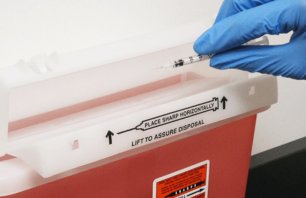July 19, 2022

Medication plays a critical role in illness recovery and chronic condition management both in formal healthcare settings and in patient homes. A key component in safe medication use is the proper disposal of unneeded pharmaceuticals. When done correctly, pharmaceutical waste management can help protect the environment and help prevent dangerous medications from getting into the wrong hands.
Pharmaceutical waste management is governed by strict and sometimes confusing requirements. To help healthcare providers and patients understand this critical—yet complex—activity, Stericycle has answered some of the most frequently asked questions about medication waste management.
Basics of Pharmaceutical Waste
What Is Pharmaceutical Waste?
Pharmaceutical waste is any leftover, unused, or expired medication that is being discarded. Patients and healthcare providers produce medication waste in formal settings, as patients recover from surgery or major illness, and in patient homes, as patients manage chronic illness and other conditions.
Is Pharmaceutical Waste Regulated as Hazardous Waste?
Between five and 10 percent of all pharmaceutical waste is considered to be “hazardous waste” by the U.S. Environmental Protection Agency (EPA). The EPA classifications depend on each medication’s chemical properties. States may regulate more pharmaceuticals as hazardous waste than the EPA.
What Are the Risks of Improper Disposal of Pharmaceutical Waste?
If disposed of incorrectly, active pharmaceutical ingredients can be released into the environment. Improper drug disposal methods can include washing drugs down sinks, flushing them down toilets, or throwing them away in the regular trash.
Improper pharmaceutical waste management can also contribute to the opioid epidemic. Leaving unneeded and addictive pain medication in patient homes rather than promptly discarding them can increase the risk that a household member could access and abuse them. Effects of pharmaceutical waste in water can be toxic to our neighborhoods.
Stericycle Can Enhance Your Pharmaceutical Waste Program
Pharmaceutical Waste Regulation
Which Agencies Regulate Pharmaceutical Waste Disposal?
Many agencies regulate pharmaceutical waste disposal.
The EPA regulates the disposal of hazardous waste pharmaceuticals through the Resource Conservation and Recovery Act (RCRA).
Other agencies that regulate pharmaceutical waste disposal include the U.S. Drug Enforcement Administration (DEA) and state boards of pharmacy.
What Is Subpart P?
In 2019, the EPA finalized a new rule, often referred to as Subpart P, that provides healthcare-specific requirements for managing hazardous waste pharmaceuticals. Some components of Subpart P include:
- Healthcare facilities can no longer flush hazardous waste pharmaceuticals down drains.
- Hazardous waste pharmaceuticals will no longer count toward an organization’s hazardous waste generator status.
- Any employee handling hazardous waste pharmaceuticals must be trained, including on emergency procedures.
Classifying Pharmaceutical Waste
Are Hazardous Drugs (HDs) and Hazardous Waste Pharmaceuticals the Same?
No. Unfortunately, these terms are used interchangeably but do not mean the same thing. The term “hazardous drug” refers to drugs found on the NIOSH list of Hazardous Drugs. The term “hazardous waste” refers to waste that is listed by the EPA (U, P, F, or K-listed) and/or exhibits a hazardous characteristic (ignitable, corrosive, reactive, and/or toxic); these items are regulated by the EPA through Subpart P. There are cases when a drug is a hazardous waste pharmaceutical and is also on the NIOSH list. There are also cases when a drug is on the NIOSH list but is not a hazardous waste pharmaceutical.
How Does the EPA Classify Organizations That Generate Hazardous Waste Pharmaceuticals?
The EPA categorizes facilities based on the volume of hazardous waste they generate. Healthcare facilities can be considered very small quantity generators (VSQG), small quantity generators (SQG), or large quantity generators (LQG). This classification informs how the EPA regulates the waste generator.
What Is a Critical Early Step In Developing a Compliant Pharmaceutical Disposal Program?
Federal law mandates that the first step for any business that generates waste is to “characterize” or identify their waste. Regardless of size or volume, there are tools and organizations like Stericycle that can assist larger generators and smaller healthcare facilities with the identification and characterization of pharmaceutical waste.
What Are the Four Types of Characteristic Hazardous Waste?
A medication is considered “hazardous” if it has one of four key characteristics:
- Ignitable. This type of waste is flammable. Examples include alcohol-based cough syrups and aerosol cans with flammable propellants.
- Corrosive. Pharmaceuticals that are preserved in corrosive materials such as nitric acid are considered corrosive. This category includes acids as well as bases and is determined by pH.
- Reactive. This waste negatively interacts with other chemicals, causing explosions or generating toxic gases or fumes. Pharmaceuticals generally do not fall into this category.
- Toxic. Although many products could be considered toxic, from a waste perspective, the EPA only designates certain chemicals as toxic if they are present in specific concentrations. To determine these concentrations, organizations can have a test performed known as the toxicity characteristic leaching procedure (TCLP). Some examples of chemicals that can be considered toxic are selenium, silver, and mercury.
On-site Management of Pharmaceutical Waste
What Are the Training Requirements for Hazardous Pharmaceutical Waste Disposal?
To ensure compliance with the EPA and state government regulations, healthcare organizations should train all staff on proper pharmaceutical waste segregation, handling, and disposal. Additionally, employees who prepare hazardous materials for transport must complete Department of Transportation hazardous materials training and be re-trained at least every three years.
Healthcare organizations should make pharmaceutical waste management training easy to complete and accessible in various forms, including web-based and on-site options, to support staff amid ongoing staff shortages.
How Can Patients and Healthcare Professionals Properly Dispose of Pharmaceutical Waste?
Effective pharmaceutical waste disposal procedures begin with a plan. Healthcare administrators should create and train employees on a detailed waste management plan that aligns with applicable EPA, DEA, and state rules.
Subpart P bans all sewer-based disposal of hazardous waste pharmaceuticals, so providers in healthcare settings should at the very least develop a plan to avoid prohibited sewering of hazardous waste pharmaceuticals.
In at-home settings, patients should consider using a drug take back program to dispose of medications. Stericycle has solutions to support in-person takeback programs and drug mail back programs.
What Color Are Pharmaceutical Waste Containers?
Hazardous pharmaceutical waste is typically collected in black containers clearly labeled “hazardous waste pharmaceuticals,” as required by the EPA. Non-hazardous pharmaceutical waste is typically collected in blue containers.
Pharmaceutical Waste Disposal and Transport
How Are Unused Pharmaceutical Products and Wastes Treated and Disposed Once They Leave the Healthcare Facility?
The EPA requires hazardous pharmaceutical waste to be treated at a permitted treatment facility before disposal. Most pharmaceutical waste is incinerated through a licensed medical incineration site.
What Is a Hazardous Waste Manifest?
A hazardous waste manifest is an EPA-required document that accompanies hazardous waste from a generator site, such as a healthcare facility to a designated hazardous waste facility. It identifies the waste-generating healthcare site, the transporter that carries the waste off-site, and the destination for the hazardous waste treatment, storage, disposal, or recycling.
Manage Pharmaceutical Waste with Stericycle
Stericycle can help your organization manage pharmaceutical waste. From compliance training to pharmaceutical waste disposal, our services are designed to fit the needs of organizations of all sizes. Learn more about pharmaceutical waste services and contact us to get started.
You may also like…
Receive Stericycle’s latest content, including news and regulations on how you can maintain business compliance.



